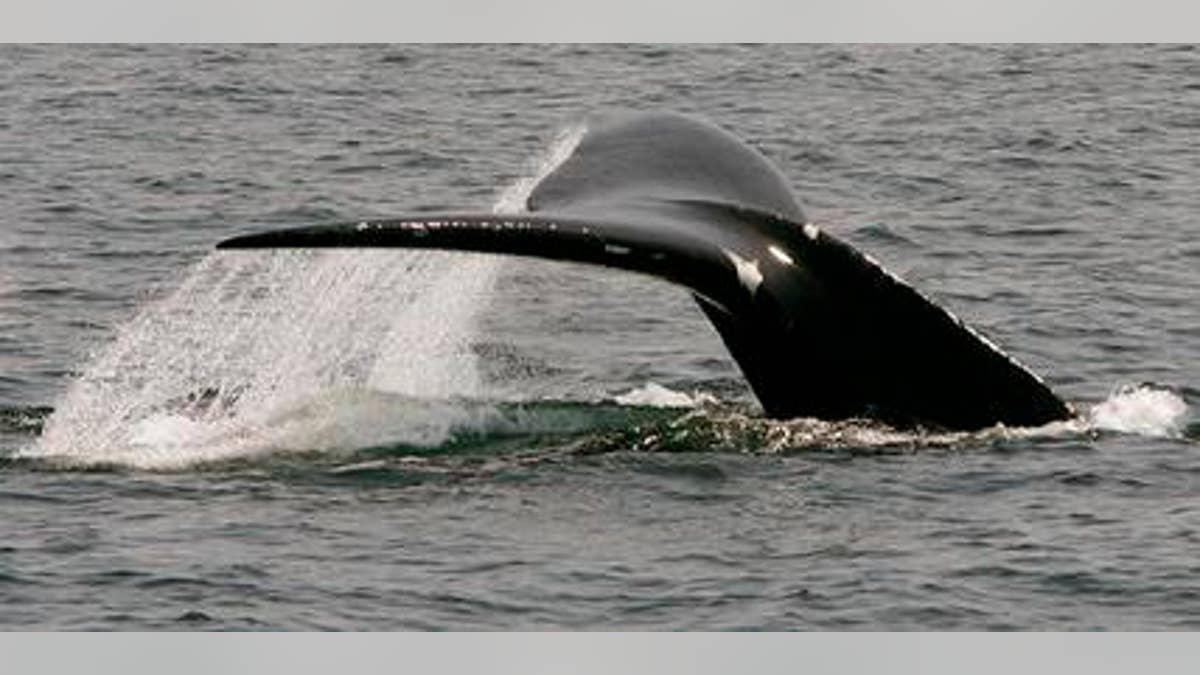
In this April 10, 2008 file photo, a North Atlantic right whale dives in Cape Cod Bay near Provincetown, Mass. The endangered whales increasingly are frequenting the bay, enticed by the fine dining possibilities of its plankton-rich waters. (AP Photo/Stephan Savoia, File)
Cape Cod is seeing a lot more of some singularly welcome tourists: endangered right whales enticed by the fine dining possibilities of its plankton-rich bay.
Experts tracking the majestic marine mammals - among the rarest creatures on the planet - say nearly half the estimated global population of 500 or so animals has been spotted in Cape Cod Bay over the past few springs.
They're back again in what looks like record numbers, thrilling amateur photographers and scientists still anguishing over their future.
"It's rather extraordinary and somewhat mind-blowing," said Charles "Stormy" Mayo, a senior scientist and director of right whale ecology at the federally-funded Center for Coastal Studies in Provincetown.
North Atlantic right whales have foraged for centuries in Cape Cod Bay, where their numbers were decimated by whalers who hunted them for their oil and plastic-like baleen bone.
But until recently, they were seldom spotted in the bay. For a stretch in the late 1990s, fewer than 30 whales were sighted each year, said Mayo, who's been surveying them and their ecosystem since 1984 by boat and plane.
"There has been a huge pulse in numbers in the past few years," said Amy Knowlton, a scientist with the New England Aquarium's Right Whale Research Project.
"Right whales are probably scouting for food all the time. Maybe when one of them finds it, they call their friends," she said.
Each whale has a unique marking on its head, and researchers use those to identify and catalog individuals. The Aquarium, which also closely monitors the population, gives specific animals amusing names such as Kleenex, Snotnose and Wart.
Right whales spend most of their time in the western Atlantic, and many are believed to congregate in the Gulf of Maine. They're rarely seen north of the entrance to the Gulf of St. Lawrence in Canada's Maritime Provinces. A few venture as far south as coastal Florida and Georgia, mainly females giving birth to calves - something scientists say doesn't happen often enough.
Their increasing presence in Cape Cod Bay has caught scientists by surprise. Mayo theorizes that shifting ocean currents - possibly due to global climate change - are pumping more plankton into the bay, even as the whales' traditional feeding grounds off the Maine coast falter.
"They're a little like cows in a field. They go away from places that are not good and go to places that are good," he said.
Although some right whales arrive in the bay in early December and linger as late as mid-May, their presence generally builds in March and peaks in mid-April, when plankton concentrations are at their highest.
The busy waters hold clear and present dangers: a risk of being struck by commercial ships and recreational boats or becoming entangled in nets.
Researchers out spotting whales report their whereabouts to state and federal authorities, who in turn alert nearby vessels. Federal law forbids getting within 500 yards of a right whale and requires ships to slow to 10 knots - roughly 11.5 miles per hour. Whale-watch tours steer clear, focusing instead on humpbacks and other comparatively plentiful species.
"It's always heartening every time we see individuals and know they're still alive," Knowlton said. "It's only through seeing them and their scars that we can really understand what's going on with them."




















